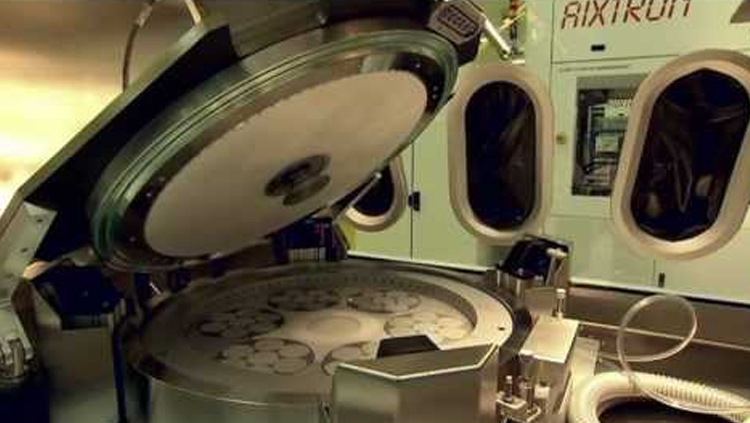University of Delaware gets $1M to transform the colour of light
![]()
Researchers at the University of Delaware in the US have received a $1 million grant from the W.M. Keck Foundation to explore a new idea that could improve solar cells, medical imaging and even cancer treatments. Their goal is to turn low-energy colours of light, such as red, into higher-energy colours, like blue or green.
Changing the colour of light would give solar technology a considerable boost. A traditional solar cell can only absorb light with energy above a certain threshold. Infrared light passes right through, its energy untapped. If that low-energy light could be transformed into higher-energy light, a solar cell could absorb much more of the sun's energy. The team predicts that their novel approach could increase the efficiency of commercial solar cells by 25 to 30 percent.
The research team, based in UD's College of Engineering, is led by Matthew Doty, associate professor of materials science and engineering and associate director of UD's Nanofabrication Facility. Doty's co-investigators include Joshua Zide, Diane Sellers and Chris Kloxin, all in the Department of Materials Science and Engineering; and Emily Day and John Slater, both in the Department of Biomedical Engineering.
Changing the colour of light
"A ray of light contains millions and millions of individual units of light called photons," says project leader Matthew Doty. "The energy of each photon is directly related to the colour of the light - a photon of red light has less energy than a photon of blue light. You can't simply turn a red photon into a blue one, but you can combine the energy from two or more red photons to make one blue photon."
This process, called "photon upconversion," isn't new, Doty says. However, the UD team's approach to it is.
They want to design a new kind of semiconductor nanostructure that will act like a ratchet. It will absorb two red photons, one after the other, to push an electron into an excited state when it can emit a single high-energy (blue) photon.
These nanostructures will be so teeny they can only be viewed when magnified a million times under a high-powered electron microscope.
"Think of the electrons in this structure as if they were at a water park," Doty says. "The first red photon has only enough energy to push an electron half-way up the ladder of the water slide. The second red photon pushes it the rest of the way up. Then the electron goes down the slide, releasing all of that energy in a single process, with the emission of the blue photon. The trick is to make sure the electron doesn't slip down the ladder before the second photon arrives. The semiconductor ratchet structure is how we trap the electron in the middle of the ladder until the second photon arrives to push it the rest of the way up."
The UD team will develop new semiconductor structures containing multiple layers of different materials, such as AlAs and GaBiAs, each only a few nanometers thick. This tailored landscape will control the flow of electrons into states with varying potential energy, turning once-wasted photons into useful energy.
The UD team has shown theoretically that their semiconductors could reach an upconversion efficiency of 86 percent, which would be a vast improvement over the 36 percent efficiency demonstrated by today's best materials. What's more, Doty says, the amount of light absorbed and energy emitted by the structures could be customized for a variety of applications, from lightbulbs to laser-guided surgery.
The UD team intends to use MBE as one technique to build nanostructures by depositing layers of atoms one at a time. The researchers also plan to develop a milk-like solution filled with millions of identical individual nanoparticles, each one containing multiple layers of different materials. The multiple layers of this structure will implement the photon ratchet idea. Through such work, the team envisions a future upconversion 'paint' that could be easily applied to solar cells, windows and other commercial products.
Biomedical applications
While the initial focus of the three-year project will be on improving solar energy harvesting, the team also will explore biomedical applications.
A number of diagnostic tests and medical treatments, ranging from CT and PET scans to chemotherapy, rely on the release of fluorescent dyes and pharmaceutical drugs. Ideally, such payloads are delivered both at specific disease sites and at specific times, but this is hard to control in practice.
The UD team aims to develop an upconversion nanoparticle that can be triggered by light to release its payload. The goal is to achieve the controlled release of drug therapies even deep within diseased human tissue while reducing the peripheral damage to normal tissue by minimising the laser power required.
"This is high-risk, high-reward research," Doty says. "High-risk because we don't yet have proof-of-concept data. High-reward because it has such a huge potential impact in renewable energy to medicine. It's amazing to think that this same technology could be used to harvest more solar energy and to treat cancer. We're excited to get started!"
Based in Los Angeles, the W.M. Keck Foundation was established in 1954 by the late W.M. Keck, founder of the Superior Oil Company. The foundation's grant making is focused primarily on pioneering efforts in the areas of medical research, science and engineering, and undergraduate education. The foundation also maintains a Southern California Grant Program that provides support for the Los Angeles community, with a special emphasis on children and youth.


































